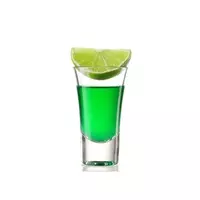Absinthe

Often, when a person is told that he loves vodka very much, it is believed that he is an alcoholic, and in the case of absinthe, they rank him as a creative person. However, if we discard the numerous image characteristics of this drink, it becomes quite obvious that absinthe is the most powerful drink that is recognized as hallucinogen in the entire history of mankind.
The main characteristics of absinthe are considered to be emerald green (although there are many other color options) and a very bitter taste (due to the presence of absentin), therefore, it is traditionally customary to pour it through a strainer with burning sugar into a vessel with cold water and use it in this form. By the way, as a result of such manipulations, absinthe acquires a cloudy white color, since essential oils fall out of the alcoholic solution of the drink. A slice of lemon or lime will help to interrupt the bitter taste of this rather specific drink.
Types of absinthe
Classifying the main types of absinthe is traditionally accepted according to different criteria, but primarily by color. The classic drink is green, with shades ranging from light green to rich emerald. Almost every manufacturer has such a drink in their catalog, but due to the fact that the color of natural dyes is short-lived, artificial substitutes are used in most cases.
Yellow absinthe is distinguished by a bright amber color, which is also created by food dyes. Such a color can be a sign of the naturalness of absinthe only in the case of natural aging of the drink a few months after the moment of manufacture. Pomegranate extract drink refers to red types of absinthe, which are characterized by an original savory aftertaste and a light ruby hue.
Of all the others, black or brown absinthe is distinguished - it does not include leaves or inflorescences of bitter wormwood, but the roots of the plant. In addition, the drink owes such a dark color to the infusion of black acacia Katehu, which introduces sweet berry tones into absinthe.
According to the strength, this alcoholic drink is usually classified into 2 types: strong (70-85 percent of alcohol) and small strength (55-65 percent).
Well, another criterion by which absinthe is divided into 3 species is the content of tuyon. Thus, drinks with a high content of this substance are released, with low and no such.
Composition of absinthe
The main component in the composition of absinthe is tuyon (a colorless substance based on bitter wormwood), due to the effect of which this alcoholic drink is released among the rest. The second component is ethyl alcohol.
In addition, the composition of absinthe can also include other plant ingredients, in particular, anise, aire, fennel, balm, mint, diagil, liquorice, coriander, white ash, chamomile, veronica and parsley.
absinthe 83.1 kCal
Energy value of absinthe (Ratio of proteins, fats, carbohydrates - ju):
Proteins: 0 g (~ 0 kCal)
Fats: 0 g (~ 0 kCal)
Carbohydrates: 8.8 g (~ 35 kCal)
Energy ratio (bj | y): 0% | 0% | 42%
 Español
Español Français
Français Português
Português Русский
Русский 简体中文
简体中文 繁體中文
繁體中文 日本語
日本語 한국어
한국어 العربية
العربية Türkçe
Türkçe Қазақ
Қазақ Deutsch
Deutsch Italiano
Italiano Українська
Українська
